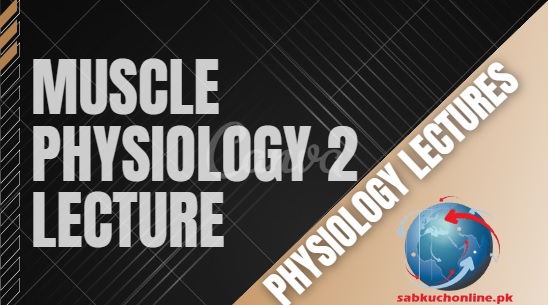Learning Objectives:
At the end of the lecture the students should be able to:
•Explain the physiological functioning of different components of sarcomere
•Explain the different phases of skeletal muscle contraction
•Describe the ionic and chemical basis of skeletal muscle contraction
•Discuss fatigue
Review of previous lecture
•Functions of muscles
•Types of muscles
•Basic characteristics of muscles
•Muscles
•Fasciculus
•Muscle fiber
•Sarcomere
•NMJ
•Excitation Contraction Coupling


Actin
•Light chains
•F-actin chains
•Made of polymerized G-Actin molecules
•1 ADP is attached to each G-actin

Tropomyosin
•Present on the actin molecule
•They are spirally wrapped around F actin helix
•In resting state they cover the active sites to prevent contraction

Troponin
•Present along the side of the tropomyosin
•They are a complex of 3 loosely bound proteins
•Troponin I
•Troponin C
•Troponin T



Myosin Molecule
•480,000
•2 heavy chains: 200,000
•4 lights chains: 20,000

Myosin
•Flexible at hinge and the attachment of head
•Head acts as ATPase enzyme
•Have sites for attachment of Actin and ATP
•Cross bridge

Mechanism of Skeletal Muscle Contraction
Sliding Filament Mechanism of Muscle Contraction
Cross-bridge interaction between
actin and myosin brings about
muscle contraction by means of
the sliding filament mechanism.

Sliding Filament Model :
•Actin myofilaments sliding over myosin to shorten sarcomeres
•Actin and myosin DO NOT change length
•Shortening sarcomeres responsible for skeletal muscle contraction
•During relaxation, sarcomeres lengthen



Walk Along or Rachet Theory

Sequence of Events







Fatigue
Muscle Fatigue
•When muscles can no longer perform a required activity, they are fatigued
•Decreased capacity to work and reduced efficiency of performance
•Basically results from inability of a contractile and metabolic processes of muscle fiber to continue supplying the same work output



Causes of Muscle Fatigue
•Depletion of Glycogen stores
•Lactic acid
•Decreased pH
•Neuro-transmitter depletion at NMJ
•Lack of blood supply
Myasthenia Gravis
•Occurance: 1 in every 20,000 persons,
•Symptoms: Muscle weakness
•Pathophysiology: Auto-immune disorder . Antibodies that attack the acetylcholine receptors
•Antibodies block or destroy their own acetylcholine receptors at the postsynaptic neuromuscular junction.
•This leads to inability of the neuromuscular junctions to transmit enough signals from the nerve fibers to the muscle fibers.



•If the disease is intense enough, the patient may die of respiratory failure as a result of severe weakness of the respiratory muscles.
•Neostigmine or some other anticholinesterase drug, which allows larger than normal amounts of acetylcholine to accumulate in the synaptic space.
